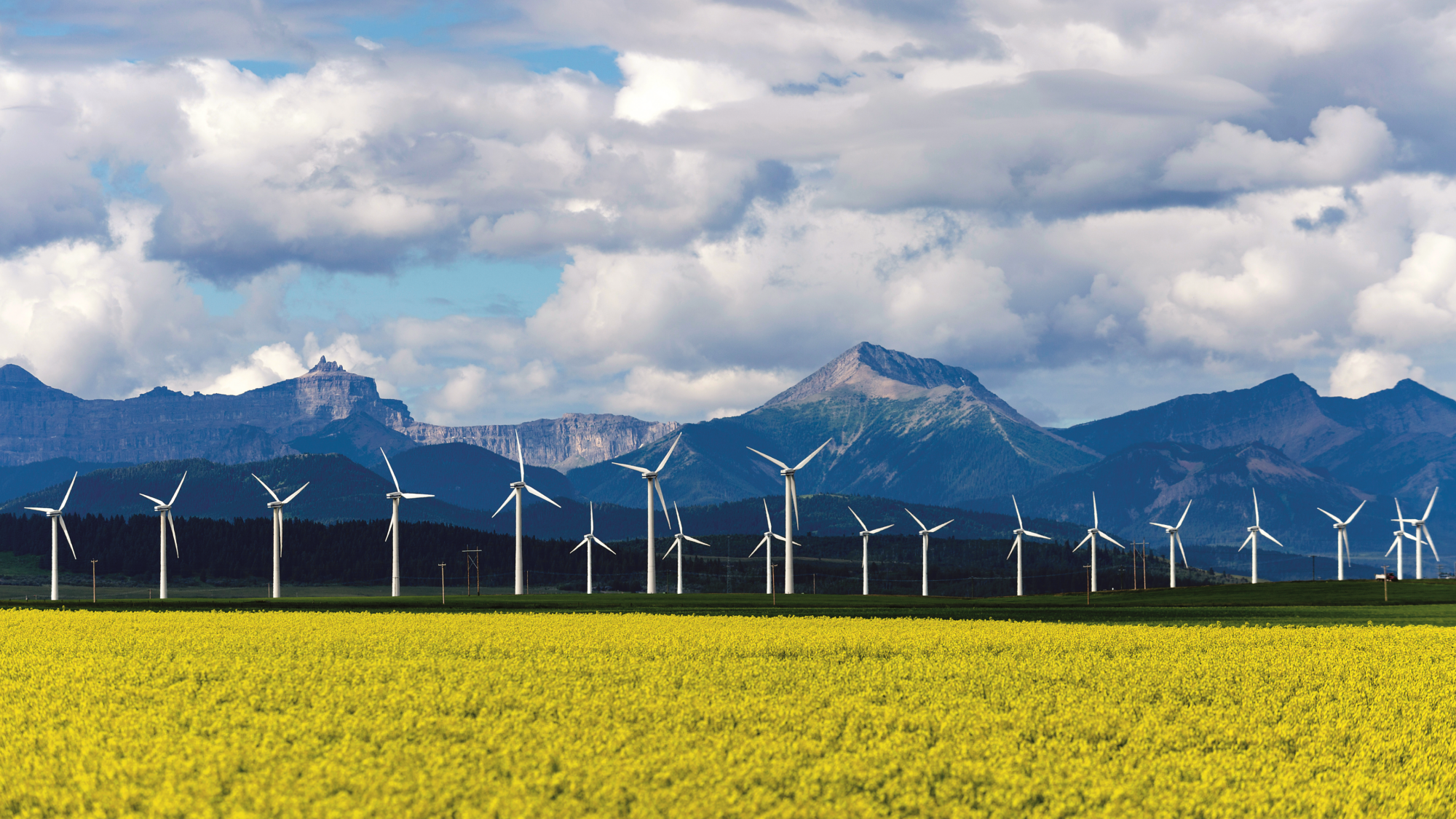Alberta has long been an energy leader—blessed by abundant natural resources above ground as well as below. The province’s infrastructure and expertise in the energy sector means that transitioning to renewable energy is a natural evolution, one that Alberta is poised to lead.
Showing the innovative entrepreneurial mindset we have long been known for, the province continues to make great strides in alternative-energy technologies, which means meeting or exceeding many voluntary targets in emissions reductions, some years ahead of schedule. The future is exciting—and, in some ways, it’s already here. Today, the province gets more power from renewable sources, such as hydro, wind and solar, than from coal, according to the Alberta Electric System Operator (AESO), which manages the provincial power grid.
Achieving ambitious goals is an Albertan strength, but the adoption of alternative sources of energy—including wind, solar, hydrogen and geothermal—is, in many cases, also occurring ahead of initial timelines. In 2016, for example, Alberta set a bold target: 30 percent of the electricity produced in the province would come from renewable energy resources by 2030. The AESO now expects this goal to be achieved by 2026, four years ahead of schedule.
Electricity generated by renewable resources in Alberta outpaced that of coal, according to AESO’s market statistics report in 2022 — which is not surprising, since our province’s natural resources include an abundance of wind and sunshine. While coal-fired power plants were responsible for half of the province’s electricity in 2015, this is no longer the case. In fact, the last coalfired power plant is set to shut down before the end of 2023. In recent years, Western Canada has accounted for a massive 98 percent of the country’s total growth in wind and solar energy sources. This growth is expected to continue. According to the AESO, at the beginning of this year, 29 solar projects were operational in Alberta, 17 were undergoing construction, 16 had been approved and 76 were announced to be in the planning phase. Meanwhile, 10 new wind facilities began operating last year, and 17 new solar farms joined the province’s fleet of energy generators.
“We are seeing a surge in solar capacity in Alberta for a number of reasons,” says Heather MacKenzie, executive director of the non-profit solar-industry group Solar Alberta. Overall, Alberta has incredible solar energy-generating potential, second only to Saskatchewan. The Prairies have lots of sunny days, (despite the cold), and Calgary averages 333 sun-filled days per year, according to World Atlas, an online educational geography resource.
New technologies are expected to be widely adopted in the coming years, especially from solar energy, notes MacKenzie. Cleaner energy is attractive to business, both for its cleaner properties and potential cost reductions. The Energy Savings in Business rebate program, introduced in 2021 by Emissions Reduction Alberta, is making solar energy more attractive for businesses and non-profits. Investors are enticed to buy solar energy and to develop solar farms here, in part because we are the only province offering long-term contracts, known as corporate power purchase agreements (PPAs).
Construction of a 58-megawatt solar farm—the first of its kind in Canada—has begun at the Shell Scotford facility, just northeast of Edmonton, which will be operated by Silicon Ranch, Shell’s North American solar platform. Scheduled for completion by the end of this year, the project is expected to produce enough renewable electricity to supply 20 percent of the refinery’s needs.
“In Canada, Shell is actively exploring alternative energy opportunities that leverage our existing infrastructure and skill-sets.” says Susannah Pierce, Shell Canada President and Country Chair. “We are reducing the carbon intensity of our operations and investing in clean-energy infrastructure and technologies to produce lower-carbon products for our customers.”
Shell’s clean-energy investments are focused on decarbonizing its operations. This includes selling cleaner-burning natural gas and providing lower-carbon fuels (such as biofuels and hydrogen) for transport. Shell is also working to provide renewable power from solar and wind sources and increasing the number of charging points for battery electric vehicles.
In 2021, Shell signed a long-term PPA with BluEarth Renewables, in Calgary, to purchase wind capacity from its Hand Hills Wind Project, located north of Drumheller. Under the terms of the agreement, Shell Energy (the U.K.-based consumer gas, electricity and broadband operations business arm of Shell) will purchase the electricity and associated emission offsets from 100 megawatts of the project’s capacity, providing its customers with clean-energy solutions to help meet their respective carbon-reduction goals.
Also in 2021, Shell and Mitsubishi signed a memorandum of understanding relating to the production of low-carbon hydrogen through the use of carbon capture, utilization and storage (CCUS) technology. Mitsubishi aims to open a low-carbon hydrogen facility near the Scotford site towards the latter half of this decade, with Shell providing carbon capture and storage via its proposed Atlas Carbon Sequestration Hub. Geothermal energy is also considered a largely untapped form of alternative energy in the province—with a huge potential upside. Aside from its geographical assets, Alberta has expertise in drilling technology and there’s potential to repurpose inactive oil and gas wells. At a facility near the town of Rocky Mountain House, in west-central Alberta, geothermal energy company Eavor is testing Eavor-Loop—a reliable, affordable form of energy generated by heat stored underground.
But geothermal energy isn’t just for industrial applications. It can also be used to power heat pumps, which can heat as well as cool homes and businesses, and is designed to work even in extreme weather. AMA is proud to have been a leader in this regard. When the AMA Edmonton Kingsway Centre was built in 2009, it was one of the largest provincial geothermal projects.
And this is just the beginning. With exciting projects being funded and announced throughout the province, it’s no surprise that alternative energy is being predicted as the next boom for Alberta.
